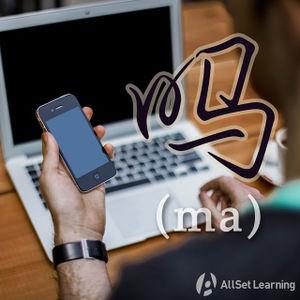Difference between revisions of "Advanced yes-no questions with "ma""
m (Text replacement - "zhīdao" to "zhīdào") |
|||
| Line 25: | Line 25: | ||
== Examples == | == Examples == | ||
| − | Note that the following examples typically contains some kind of "verb of understanding" such as 知道 ( | + | Note that the following examples typically contains some kind of "verb of understanding" such as 知道 (zhīdào),了解 (liǎojiě), 明白 (míngbai), 认识 (rènshi), etc. Then "吗" (ma) can still be added at the end of the question, turning it into a kind of confirmation. For example: |
<div class="liju"> | <div class="liju"> | ||
* 这 是 什么 东西 ?<span class="pinyin">Zhè shì shénme dōngxī?</span><span class="trans">What is this thing?</span> | * 这 是 什么 东西 ?<span class="pinyin">Zhè shì shénme dōngxī?</span><span class="trans">What is this thing?</span> | ||
| − | * <strong>你 知道</strong> 这 是 什么 东西 <em>吗</em>?<span class="pinyin"><strong>Nǐ | + | * <strong>你 知道</strong> 这 是 什么 东西 <em>吗</em>?<span class="pinyin"><strong>Nǐ zhīdào</strong> zhè shì shénme dōngxī <em>ma</em>?</span><span class="trans">Do you know what this thing is?</span> |
</div> | </div> | ||
| Line 37: | Line 37: | ||
* 他 是 谁 ?<span class="pinyin">Tā shì shéi?</span><span class="trans">Who is he?</span> | * 他 是 谁 ?<span class="pinyin">Tā shì shéi?</span><span class="trans">Who is he?</span> | ||
| − | * 你 <strong>知道</strong> 他 是 谁 <em>吗</em>?<span class="pinyin">Nǐ <strong> | + | * 你 <strong>知道</strong> 他 是 谁 <em>吗</em>?<span class="pinyin">Nǐ <strong>zhīdào</strong> tā shì shéi <em>ma</em>?</span><span class="trans">Do you know who he is?</span> |
</div> | </div> | ||
| Line 58: | Line 58: | ||
* 怎么 学 中文 ?<span class="pinyin">Zěnme xué Zhōngwén?</span><span class="trans">How does one learn Chinese?</span> | * 怎么 学 中文 ?<span class="pinyin">Zěnme xué Zhōngwén?</span><span class="trans">How does one learn Chinese?</span> | ||
| − | * 你 <strong>知道</strong> 怎么 学 中文 <em>吗</em>?<span class="pinyin">Nǐ <strong> | + | * 你 <strong>知道</strong> 怎么 学 中文 <em>吗</em>?<span class="pinyin">Nǐ <strong>zhīdào</strong> zěnme xué Zhōngwén <em>ma</em>?</span><span class="trans">Do you know how to learn Chinese?</span> |
</div> | </div> | ||
| Line 65: | Line 65: | ||
* 他 叫 什么 名字 ?<span class="pinyin">Tā jiào shénme míngzì?</span><span class="trans">What is his name?</span> | * 他 叫 什么 名字 ?<span class="pinyin">Tā jiào shénme míngzì?</span><span class="trans">What is his name?</span> | ||
| − | * 你 <strong>知道</strong> 他 叫 什么 名字 <em>吗</em>?<span class="pinyin">Nǐ <strong> | + | * 你 <strong>知道</strong> 他 叫 什么 名字 <em>吗</em>?<span class="pinyin">Nǐ <strong>zhīdào</strong> tā jiào shénme míngzì <em>ma</em>?</span><span class="trans">Do you what his name is?</span> |
</div> | </div> | ||
| Line 72: | Line 72: | ||
* 王 老师 在 哪里 ?<span class="pinyin">Wáng lǎoshī zài nǎlǐ?</span><span class="trans">Where is Teacher Wang?</span> | * 王 老师 在 哪里 ?<span class="pinyin">Wáng lǎoshī zài nǎlǐ?</span><span class="trans">Where is Teacher Wang?</span> | ||
| − | * 你 <strong>知道</strong> 王 老师 在 哪里 <em>吗</em>?<span class="pinyin">Nǐ <strong> | + | * 你 <strong>知道</strong> 王 老师 在 哪里 <em>吗</em>?<span class="pinyin">Nǐ <strong>zhīdào</strong> wáng lǎoshī zài nǎlǐ <em>ma</em>?</span><span class="trans">Do you know where Teacher Wang is?</span> |
</div> | </div> | ||
Revision as of 01:27, 17 January 2017
-
Level
-
Similar to
-
Used for
-
Keywords
The question particle 吗 (ma) is a very simple way to convert it into a "yes/no question," and beginners will learn not to use 吗 with other question words, because it's redundant. More advanced students, however, will note that 吗 has some more complicated structures that do involve combining it with question words in order to ask very specific types of confirming questions.
Structure
You'll remember that this is the simple pattern for yes/no questions:
Statement + 吗 ?
If you embed a question that uses a question word instead of a statement, you can create a more complex kind of "confirming" 吗 (ma) question:
[Question-word Question] + 吗 ?
Examples of common question words include 什么 (shénme), 谁 (shéi), and 哪里 (nǎli).
Examples
Note that the following examples typically contains some kind of "verb of understanding" such as 知道 (zhīdào),了解 (liǎojiě), 明白 (míngbai), 认识 (rènshi), etc. Then "吗" (ma) can still be added at the end of the question, turning it into a kind of confirmation. For example:
- 这 是 什么 东西 ?What is this thing?
- 你 知道 这 是 什么 东西 吗?Do you know what this thing is?
- 他 是 谁 ?Who is he?
- 你 知道 他 是 谁 吗?Do you know who he is?
- 这 是 什么 意思 ?What is the meaning of this?
- 你 明白 这 是 什么 意思 吗?Do you understand the meaning of this?
- 他 的 问题 是 什么 ?What is his question?
- 你 明白 他 的 问题 是 什么 吗?Do you understand what his question is?
- 怎么 学 中文 ?How does one learn Chinese?
- 你 知道 怎么 学 中文 吗?Do you know how to learn Chinese?
- 他 叫 什么 名字 ?What is his name?
- 你 知道 他 叫 什么 名字 吗?Do you what his name is?
- 王 老师 在 哪里 ?Where is Teacher Wang?
- 你 知道 王 老师 在 哪里 吗?Do you know where Teacher Wang is?
See also
Sources and further reading
Books
- Chinese: An Essential Grammar, Second Edition (pp. 138-40) →buy
- Integrated Chinese: Level 1, Part 1 (3rd ed) (pp. 29-30) →buy
- New Practical Chinese Reader 1 (新实用汉语课本1) (p. 21) →buy
- New Practical Chinese Reader 1 (新实用汉语课本1)(2nd ed) (pp. 23, 250) →buy



